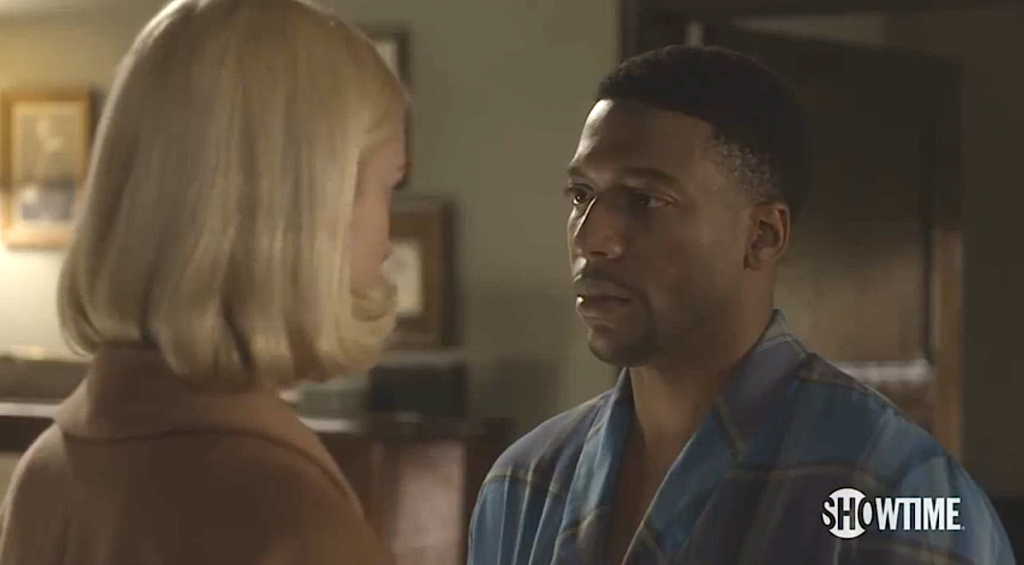Note: Spoilers for seasons one and two of Masters of Sex are below.
The Showtime television program Masters of Sex focuses on the real-life American sex researchers William H. Masters (1915–2001) and Virginia E. Johnson (1925–2013). Masters and Johnson are best known for their first two book-length sex research studies: Human Sexual Response (1966) and Human Sexual Inadequacy (1970), which introduced the reading public to the four-stage sexual response cycle: excitement, plateau, orgasm, and resolution and to sex therapy for heterosexual married couples. In addition to storylines about the research itself and the researchers’ complicated personal lives, the writers and producers also include storylines that address questions of race in St. Louis, Missouri, in the late 1950s and early 1960s.

Throughout the program so far, the primary interracial storylines are mostly enacted, not through Masters and Johnson themselves or through their research, but through Masters’ wife, Libby (dubbed “Race Relations Barbie” by one reviewer) as she awkwardly manages a household with African-American part- and full-time help. In the last two episodes of season two, having started volunteering with the civil rights group Southern Christian Leadership Conference, she meets and has sex with a local African-American activist, Robert Franklin. In the final episode, it is unclear whether Libby is using Robert as a means to escape her marriage to her unfaithful husband, or whether she genuinely cares for him.
However, the television writers’ attempts to address not only race but also racism are often heavy-handed and fail to illustrate Masters and Johnson’s thoughts about the intersection of race and sexual behavior. For the real-life Masters and Johnson, as shown in their published books and articles from the 1950s through the 1970s, race tended to be a muted category of analysis. In Human Sexual Response, they mention their African-American subjects as a group only once:
There were 11 Negro family units, 3 of privileged and 8 of underprivileged backgrounds, included in the study subject population. In addition, two Negro women were evaluated without marital partners. One was a surgical castrate and the other had an artificial vagina. In view of the small number of Negro families in the study-subject population, it is obvious that the population has, over the years, been weighted toward the Caucasian rather than the Negro race (pp. 14–15).
Their low level of attention to race suggests that they believed that race did not affect sexual anatomy or physiology — or at least not enough for them to spend time exploring race as a social category that might or might not affect behavior. As Washington University, where Masters was initially based, was slowly being desegregated in the late 1950s, he and Johnson did not make a special effort to seek out African-American subjects. (They also never worked at an African-American hospital, which was a brief storyline in season two of the program.) Nor did they highlight differences between white subjects and their small numbers of African-American subjects. But African-Americans in the late 1960s were not silent about their views of and near-absence in the Masters and Johnson texts.
Dr. Alyce C. Gullattee, a professor at Howard University College of Medicine, thought that Masters and Johnson paid little attention to black sexualities because “blacks are better adjusted sexually than whites, [so] they have less need to discuss intimate matters with sex researchers” (“Black Sexual Myths,” New York Amsterdam News, June 19, 1971, p. 8). An article in Jet magazine, however, praised Human Sexual Response for not finding difference between African-American and white sexualities, stating, “This finding that Negroes have no peculiar sexuality makes a lie of centuries of distortion by whites” (Francis Ward, “Negroes Studied during Sex Act,” Jet, May 19, 1966). Another author disagreed, thinking that “perhaps white researchers anticipated that the findings might threaten the white man’s sense of sexual adequacy and therefore ignored blacks” (Alvin F. Poussaint, “Sexual Revolution,” Ebony, October 1971, p. 114). These African-Americans, and many others whose thoughts were not recorded, had diverse responses to a body of work that both affirmed their lack of difference from whites and made them nearly invisible as subjects. Whereas Masters and Johnson did not appear interested in the responses of their African-American readership, those readers viewed Human Sexual Response and Human Sexual Inadequacy as critical texts for African-American sexualities and as springboards for future research.
Masters of Sex starts, but has yet to finish, conversations about how sexual scientists in the past perceived racial and sexual similarities and differences. It also addresses, but does not fully answer, how sexual science affects public thought. Bringing together a civil rights movement like the Southern Christian Leadership Conference through the character of Robert, and the sexual revolution that Masters and Johnson fomented through Human Sexual Response, the makers of Masters of Sex have the potential, in season three, to demonstrate how sexual science has changed (and not changed) popular ideas of sex and race over time, and how race, in turn, affected sexual science. Stay tuned.

Donna J. Drucker is Assistant Director of the Office of Scholarship and Research Development at the Columbia University School of Nursing. She is the author of The Machines of Sex Research, The Classification of Sex, Contraception, and Fertility Technology.

NOTCHES: (re)marks on the history of sexuality is licensed under a Creative Commons Attribution-NonCommercial-NoDerivatives 4.0 International License.
Based on a work at www.notchesblog.com.
For permission to publish any NOTCHES post in whole or in part please contact the editors at NotchesBlog@gmail.com




